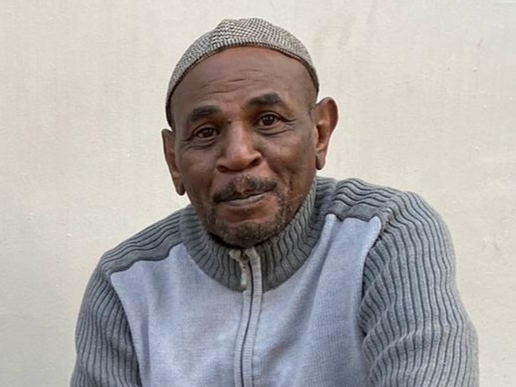Seif Laota (Khartoum College of Fine Arts) works in Khartoum and Dubai, had exhibitions in Europe, Asia and the Middle East, but life along the Nile is center stage in Laota’s drawings and paintings. We recognize in his paintings the tall inhabitants, in their white robes, the square shapes of houses clustered in villages, and we recognize the same symbols each time: the triangular shapes of the clay ornaments of houses – that may be a crocodile’s tooth too, the moon and the crescent – that may be cow’s horns as well or again a woman’s arms carrying wares on her head. His figurative art is fierce and vibrant, highly modern and yet steeped in tradition.
‘Art propels humankind’
Seif Laota is firm: art does not exist by itself, but is created through its observer. Looking at art and seeing what you see is part of the creation of art for Laota. When visitors come to his atelier in Khartoum to look at his paintings, it is often hard for Laota to say what exactly he has painted: is it a cow? The moon? A female figure? ‘It is up to you’, you can hear him say, ‘whatever you see in it’. The image is but the vessel through which meaning is transmitted. For Laota, art is a way to view beyond oneself.
Laota was born an artist, he says. Already during the first years in primary school, he drew illustrations for his teachers to use in class. Growing up in a small town along the Nile, his father urged him to get a safe white-collar job later. But from a very early age onwards he knew he wanted to be an artist: ‘I wanted to make something real’. Laota believes his father allowed him to become the glocal artist that he is because he recognized his talent.
After graduating from the Khartoum College of Fine Arts (1978), Laota has painted and drawn thousands of works. They belong to private collections, and have been exhibited and are part of permanent collections in Asia (Tokyo, Pyong Yang, Beijing, Seoul), Europe (Paris, UK, Bratislava, Hamburg), and the Middle East and Gulf (Damascus, Jeddah, Dubai, Cairo, Kuwait). He has won several awards (Noma award, Japan, gold medal 1995, silver 1984, runner-up 1986). He currently lives and works in Khartoum and Dubai.
Laota works with any kind of material: acrylic, oil paint, ink, watercolour, on paper, linen, carton. Once he sits down to work, a picture comes, a vision and he then ‘gives the material a soul, meaning, ideas’. Laota transmits these through his images. Whether the artwork is large sober paintings for corporate offices, minimalistic ink drawings with blotted impressions of tall shapes, rich and detailed children’s books, or colourful and intimate almost mystical scenes, they represent for Laota the age-old knowledge and wisdom of the Nubian people ‘that cannot be taught’, he says.
The cultural symbols stemming from Sudan’s ancient civilisations along the Nile, the viewer starts to recognize. It is the triangles, merging squares of the houses, repetition of circles that can be faces or the moon, the tall dark-skinned people in contrasting swooping white robes, congregating or sitting pensively, cats and cows, or indefinable beings in-between – embedded in new, modern colours with so often dark ink blots. ‘A painting is a house for old souls’, Laota says, challenging us to discover ourselves through his work, to transform our world in creating a new vision from the age-old wisdom, finding a new meaning beyond ourselves.

